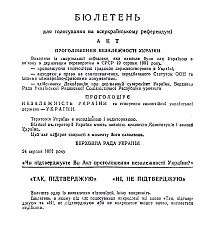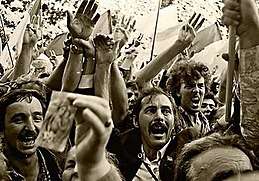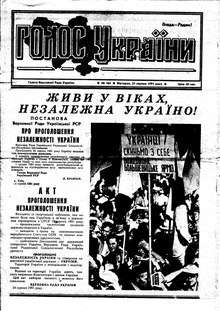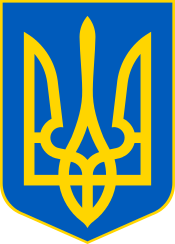Declaration of Independence of Ukraine
The Act of Declaration of Independence of Ukraine (Ukrainian: Акт проголошення незалежності України, translit. Akt proholoshennya nezalezhnosti Ukrayiny) was adopted by the Ukrainian parliament on 24 August 1991.[1] The Act reestablished Ukraine's state independence.[2][1]
| Act of Declaration of Independence of Ukraine Ukrainian: Акт проголошення незалежності України | |
|---|---|
 As printed on the ballot for the national referendum on 1 December 1991. | |
| Created | 24 August 1991 |
| Ratified | 24 August 1991 |
| Location | Central State Archive of the higher governing bodies of Ukraine, Kiev. |
| Author(s) | Levko Lukyanenko |
| Signatories | Leonid Kravchuk |
| Purpose | Declaration of independence |
Adoption
The Act was adopted in the aftermath of the coup attempt on 19 August when hardline Communist leaders of the Soviet Union tried to restore central Communist party control over the USSR.[1] In response (during a tense 11-hour extraordinary session[3]), the Supreme Soviet (parliament) of the Ukrainian SSR in a special Saturday session overwhelmingly approved the Act of Declaration.[1] The Act passed with 321 votes in favor, 2 votes against, and 6 abstentions (out of 360 attendants).[3] The text was largely composed during the night of 23 August–24 August mainly by Levko Lukyanenko, Serhiy Holovatyi, Mykhailo Horyn, Ivan Zayets and Vyacheslav Chornovil.[4]
The Communists (CPU), being persuaded behind the scenes by their fellow Party member and Supreme Soviet Chairman Leonid Kravchuk,[4] felt compelled to support the act in order to distance themselves from the coup.[3] CPU First Secretary Stanislav Hurenko argued that "it will be a disaster" if the CPU didn't support independence.[3] CPU members had been unnerved by the news of former party leader Vladimir Ivashko's arrest in Moscow, the re-subordination of the Soviet Army under the leaders of the Russian SFSR and the sealing of the Communist Party Central Committee's premises.[4]


The same day (24 August), the parliament called for a referendum on support for the Declaration of Independence.[1][3] The proposal for calling the national referendum came jointly from opposition leaders Ihor Yukhnovsky and Dmytro Pavlychko.[3] The Parliament also voted for the creation of a national guard of Ukraine and turned jurisdiction over all the armed forces located on Ukrainian territory over to itself.[3]
Other than a noisy crowd that had gathered at the Parliament building, the streets of Kiev were quiet that day, with few signs of open celebration.[3]
In the days that followed a number of resolutions and decrees were passed: nationalizing all CPU property and handing it over to the Supreme Soviet and local councils; issuing an amnesty for all political prisoners; suspending all CPU activities and freezing CPU assets and bank accounts pending official investigations into possible collaboration with the Moscow coup plotters; setting up a committee of inquiry into official behavior during the coup; and establishing a committee on military matters related to the creation of a Ministry of Defense of Ukraine.[3]
On 26 August 1991 the Permanent Representative of the Ukrainian SSR to the United Nations (the Ukrainian SSR was a founding member of the United Nations[5]) Hennadiy Udovenko informed the office of the Secretary General of the United Nations that his permanent mission to this international assembly would officially be designated as representing Ukraine.[5][6] That same day, the executive committee of Kiev also voted to remove all the monuments of Communist heroes from public places, including the Lenin monument on the central October Revolution Square.[3] The large square would be renamed Maidan Nezalezhnosti (Independence Square) as would the central Metro station below it, the executive committee decided.[3]
Two days later, more than 200,000 Lviv and Lviv oblast residents declared their readiness to serve in the national guard.[7]
In the independence referendum on 1 December 1991, the people of Ukraine expressed widespread support for the Act of Declaration of Independence, with more than 90% voting in favor, and 82% of the electorate participating.[1] The referendum took place on the same day as Ukraine's first direct presidential election; all six presidential candidates supported independence and campaigned for a "yes" vote. The referendum's passage ended any realistic chance of the Soviet Union staying together even on a limited scale; Ukraine had long been second only to Russia in economic and political power.
A week after the election, newly elected president Leonid Kravchuk joined his Russian and Belarusian counterparts in signing the Belavezha Accords, which declared that the Soviet Union had ceased to exist.[8] The Soviet Union officially dissolved on 26 December.[9]
Since 1992, the 24th of August is celebrated in Ukraine as Independence Day.[10]
International recognition
Poland and Canada were the first countries to recognize Ukraine's independence, both on 2 December 1991.[11] The same day (2 December) it was reported during the late-evening airing of the television news program Vesti that the President of the Russian SFSR, Boris Yeltsin, had recognized Ukraine's independence.[12]
The United States did so on 25 December 1991.[13] That month the independence of Ukraine was recognized by 68 states, and in 1992 it was recognized by another 64 states.[14]
| Date | Country |
|---|---|
| December 2, 1991 | |
| December 2, 1991 | |
| December 2, 1991 | |
| December 3, 1991 | |
| December 4, 1991 | |
| December 4, 1991 | |
| December 5, 1991 | |
| December 5, 1991 | |
| December 5, 1991 | |
| December 5, 1991 | |
| December 9, 1991 | |
| December 11, 1991 | |
| December 12, 1991 | |
| December 16, 1991 | |
| December 16, 1991 | |
| December 18, 1991 | |
| December 20, 1991 | |
| December 20, 1991 | |
| December 23, 1991 | |
| December 23, 1991 | |
| December 24, 1991 | |
| December 24, 1991 | |
| December 25, 1991 | |
| December 25, 1991 | |
| December 25, 1991 | |
| December 25, 1991 | |
| December 25, 1991 | |
| December 25, 1991 | |
| December 26, 1991 | |
| December 26, 1991 | |
| December 26, 1991 | |
| December 28, 1991 | |
| December 26, 1991 | |
| December 26, 1991 | |
| December 26, 1991 | |
| December 26, 1991 | |
| December 26, 1991 | |
| December 26, 1991 | |
| December 27, 1991 | |
| December 27, 1991 | |
| December 27, 1991 | |
| December 27, 1991 | |
| December 27, 1991 | |
| December 27, 1991 | |
| December 27, 1991 | |
| December 27, 1991 | |
| December 28, 1991 | |
| December 28, 1991 | |
| December 28, 1991 | |
| December 28, 1991 | |
| December 29, 1991 | |
| December 30, 1991 | |
| December 30, 1991 | |
| December 30, 1991 | |
| December 30, 1991 | |
| December 31, 1991 | |
| December 31, 1991 | |
| December 31, 1991 | |
| December 31, 1991 | |
| December 31, 1991 | |
| December 31, 1991 | |
| December 31, 1991 | |
| December 31, 1991 | |
| January 1, 1992 | |
| January 2, 1992 | |
| January 2, 1992 | |
| January 2, 1992 | |
| January 3, 1992 | |
| January 3, 1992 | |
| January 3, 1992 | |
| January 4, 1992 | |
| January 5, 1992 | |
| January 7, 1992 | |
| January 8, 1992 | |
| January 10, 1992 | |
| January 17, 1992 | |
| January 19, 1992 | |
| January 22, 1992 | |
| January 24, 1992 | |
| February 6, 1992 | |
| February 11, 1992 | |
| February 14, 1992 | |
| March 4, 1992 | |
| May 7, 1992 | |
| June 2, 1992 | |
| June 8, 1992 | |
| July 23, 1993 |
- Recognition of Ukraine's independence by the RSFSR was announced on 2 December 1991 by Boris Yeltsin during that day's edition of the late-evening news program Vesti[12]
- De jure constituent republic of SFR Yugoslavia to 15 January 1992. De facto independent state
- De jure constituent republic of the Soviet Union to 26 December 1991. De facto independent state
(Text of) Act of Independence
 |
|---|
| This article is part of a series on the politics and government of Ukraine |
|
Presidency
|
|
Executive |
|
|
|
| Wikisource has original text related to this article: |
Act of Declaration of Independence of Ukraine
- In view of the mortal danger surrounding Ukraine in connection with the state coup in the USSR on August 19, 1991,
- Continuing the thousand-year tradition of state development in Ukraine,
- Proceeding from the right of a nation to self-determination in accordance with the Charter of the United Nations and other international legal documents, and
- Implementing the Declaration of State Sovereignty of Ukraine,
the Verkhovna Rada of the Ukrainian Soviet Socialist Republic solemnly declares
the Independence of Ukraine and the creation of an independent Ukrainian state – UKRAINE.The territory of Ukraine is indivisible and inviolable.
From this day forward, only the Constitution and laws of Ukraine are valid on the territory of Ukraine.
This act becomes effective at the moment of its approval.
— VERKHOVNA RADA OF UKRAINE, August 24, 1991
References
- A History of Ukraine: The Land and Its Peoples by Paul Robert Magocsi, University of Toronto Press, 2010, ISBN 1442610212 (page 722/723)
- Volodymyr Vasylenko. Non-nuclear status of Ukraine: past, present, and future (Без’ядерний статус України: минуле, сучасне, майбутнє). The Ukrainian Week. 31 May 2018
- Historic vote for independence, The Ukrainian Weekly (1 September 1991)
- A reform that ruined the Soviet Union, The Ukrainian Week (10 November 2018)
- "Activities of the Member States - Ukraine". United Nations. Retrieved 2011-01-17.
- U.N. Mission stresses statehood of Ukraine, The Ukrainian Weekly (1 September 1991)
- NEWSBRIEFS FROM UKRAINE, The Ukrainian Weekly (1 September 1991)
- Historical Dictionary of the Russian Federation by Robert A. Saunders & Vlad Strukov, Scarecrow Press, 2010, ISBN 0810854759 (page 75)
- Turning Points – Actual and Alternate Histories: The Reagan Era from the Iran Crisis to Kosovo by Rodney P. Carlisle and J. Geoffrey Golson, ABC-CLIO, 2007, ISBN 1851098852 (page 111)
- Ukraine Intelligence & Security Activities and Operations Handbook, International Business Publications, 2009, ISBN 0739716611 (page 268)
- Ukraine and Russia: The Post-Soviet Transition by Roman Solchanyk, Rowman & Littlefield Publishers, 2000, ISBN 0742510182 (page 100)
Canadian Yearbook of International Law, Vol 30, 1992, University of British Columbia Press, 1993, ISBN 9780774804387 (page 371)
Russia, Ukraine, and the Breakup of the Soviet Union by Roman Szporluk, Hoover Institution Press, 2000, ISBN 0817995420 (page 355 - "Ex-Communist Wins in Ukraine; Yeltsin Recognizes Independence". The New York Times. 3 December 1991. Retrieved 20 August 2017.
- A Guide to the United States' History of Recognition, Diplomatic, and Consular Relations, by Country, since 1776: Ukraine, Office of the Historian
The Limited Partnership: Building a Russian-US Security Community by James E. Goodby and Benoit Morel, Oxford University Press, 1993, ISBN 0198291612 (page 48) - Ukrainian Independence, Worldwide News Ukraine
External links
- (in Ukrainian) Act of Declaration of Independence of Ukraine – Official Verkhovna Rada website
- (in English) Act of Declaration of Independence of Ukraine – Official Verkhovna Rada website
- (in English) Act of Declaration of the Independence of Ukraine – The Ukrainian Weekly, translation by The Ukrainian Weekly
- (in English) Declaration of Independence of Ukraine – The Windsor Viter, Volume 12, Number 1, July, 2001 Part 2, translation by Andrew Gregorovich
- (in Ukrainian) "Great Saturday" – an interview with writer and parliament deputy Stepan Pushyk on the events of August 24, 1991.